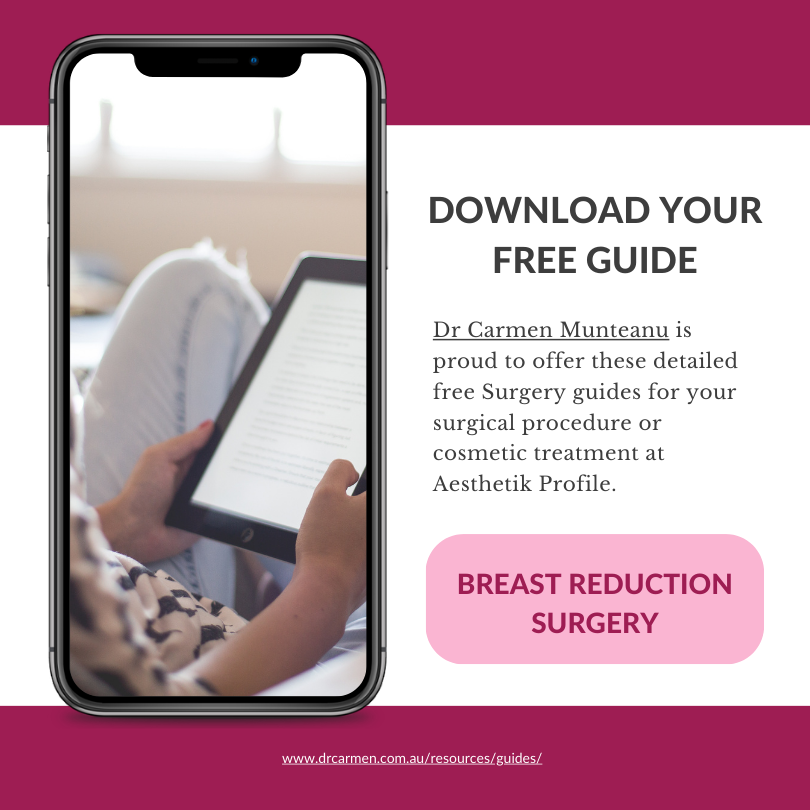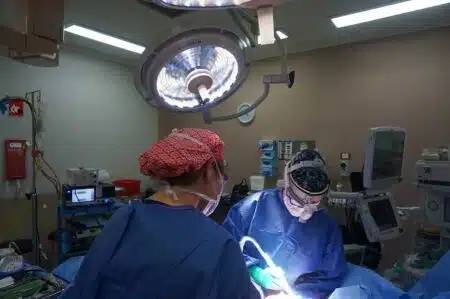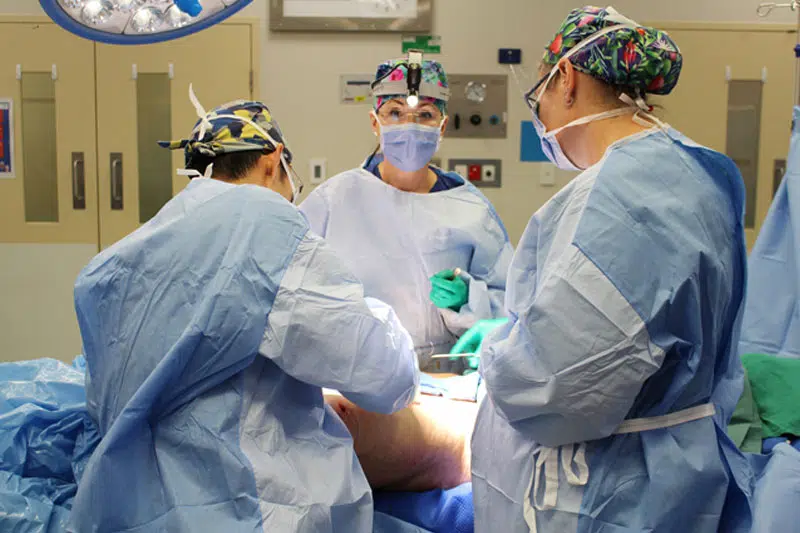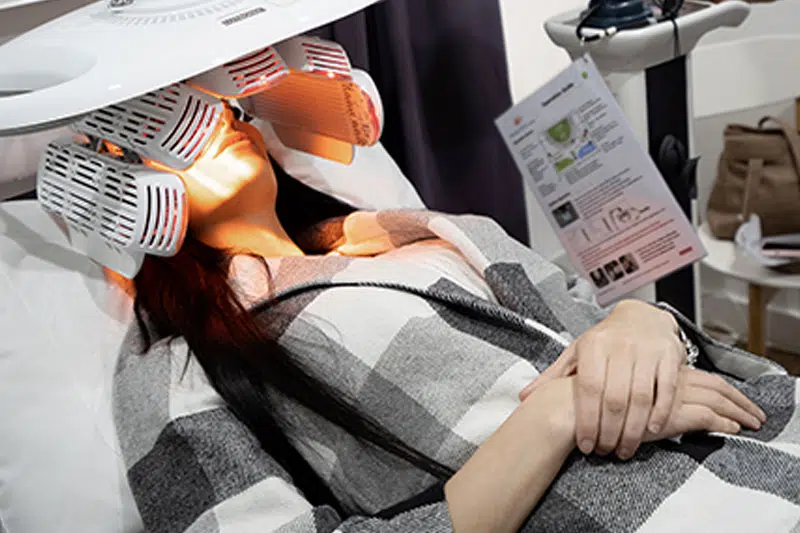Reducing Breast Size with Diet and Exercise – Is It Possible?
Breast size, an aspect of our bodies that often sparks curiosity and questions, especially when it comes to the impacts of diet and exercise. It’s worth noting that the relationship between breast size and lifestyle changes, such as adjustments in diet or exercise routines, is not straightforward. Breasts are composed of fat, glandular, and connective tissues, and changes in their size can be influenced by a variety of factors, including overall body weight, hormonal shifts, and genetics. Health and body changes are highly individualised, and what might be effective for one person may not necessarily apply to another.
Dr Carmen Munteanu MD. FRACS (Plas) is one of Melbourne’s experienced female plastic surgeons who can help you if you are interested in Breast Reduction, Breast Lift and Breast Implant Surgery.
Download Dr Carmen’s Breast Reduction Surgery – Reduction Mammaplasty Guide

Understanding Breast Composition
Let’s get a clear picture of what makes up your breasts. This understanding is key when considering changes in breast size related to diet and exercise.
Your breasts are made up of several types of tissues: glandular tissue, fat, and connective tissue. Glandular tissue is what produces milk; it’s made up of lobes and ducts. The fat in your breasts surrounds the glandular tissue and gives breasts their size and softness. Then there’s the connective tissue, which holds everything together and maintains the shape.
How much of each type of tissue you have in your breasts is largely determined by genetics. That means if women in your family tend to have larger or smaller breasts, there’s a good chance you might follow a similar pattern. But it’s not just genetics at play here.
Hormones, especially oestrogen, play a significant role in determining your breast size. During different stages of life, like puberty, pregnancy, or menopause, hormonal changes can cause fluctuations in breast size. For instance, during pregnancy, your breasts might enlarge due to hormonal changes and the body preparing for breastfeeding.
So, while diet and exercise can impact the amount of fat in your breasts, they won’t affect the glandular tissue. That’s why you might notice some changes in breast size if you lose or gain weight, but these changes can be quite different for everyone.
General Weight Loss and Its Impact on Breast Size
When you’re looking to understand how losing weight might affect your breast size, it’s important to start with the basics. Your breast size is partly determined by the amount of fat you have in your body. As breasts contain fat, changes in your overall body fat can lead to changes in breast size.
Here’s the straightforward bit: when you lose weight, you’re reducing the fat stored throughout your body. This may also includes the fat in your breasts. So, in many cases, weight loss can lead to a reduction in breast size. However, how much change you see can vary greatly from person to person.
Why is there such individual variability? Well, it comes down to your body’s unique composition and how it stores fat. Some people might find that their breasts are one of the first areas where they lose fat, while others might notice weight loss in different areas first, like the hips or belly.
It’s also key to understand that while losing weight can reduce the fat in your breasts, it doesn’t affect the glandular tissue responsible for milk production. So, the impact of weight loss on breast size can be limited for some, especially if their breasts contain a higher proportion of glandular tissue.
Dietary Approaches to Weight Loss
When it comes to weight loss, what you eat plays a big part. But it’s not just about eating less; it’s about eating right. A balanced diet is key to losing weight in a way that’s good for your whole body, including your breasts.
Eating habits should focus on a variety of foods that give you the nutrients you need. Think fruits, vegetables, whole grains, lean proteins, and monounsaturated as well as polyunsaturated fats. Eating a balanced diet helps ensure your body gets the right kind of fuel. It’s not just about cutting calories; it’s about making those calories count.
Now, there are specific diets that some find helpful for weight reduction. For instance, the Mediterranean diet focuses on plant-based foods, whole grains, fish, and oils known for nutritional benefits. It is good for the heart and can also aid in weight loss. Then there are low-carb diets, which reduce carbohydrate intake in favour of proteins and fats. These diets can be effective for some, but remember, what works for one person might not work for you.
The key to any diet is balance. Drastically cutting calories or certain food groups can lead to nutrient deficiencies and might not be sustainable in the long run. Plus, a sudden and significant drop in calorie intake can impact your breast tissue. Since a portion of breast tissue is fat, significant weight loss might lead to changes in breast size and shape.
Exercise and Its Role in Weight Management
When it comes to managing your weight, exercise is just as important as diet. It’s not only about burning calories; it’s about enhancing your well-being. Let’s look at how different types of exercise can help with weight loss and how they affect your body, including your breasts.
- Cardio Exercises: Activities like running, swimming, or cycling are great for burning calories and improving heart health. When you do cardio, you’re working out your whole body, which can lead to overall fat loss. This includes fat in the breast area, but remember, it’s part of a more general weight loss
- Strength Training: Lifting weights or using resistance bands helps build muscle. More muscle means your body burns more calories, even at rest. Strength training won’t specifically reduce breast size, but it can help tone your body overall, including the chest area
Exercises for the Chest Area
Exercises like push-ups, chest presses, or dumbbell flies can strengthen and tone the muscles under your breasts, the pectorals. Toning these muscles can give your chest a firmer appearance, but it won’t directly reduce breast size since you can’t target fat loss in specific areas.
Safety Precautions and Recommended Routines
It’s important to exercise safely:
- Start Slow: If you’re new to exercise, begin with shorter, less intense workouts and gradually increase the intensity
- Use Proper Form: This helps prevent injuries. If you’re unsure about how to do an exercise, seek advice from a fitness professional
- Listen to Your Body: If something hurts, stop. There’s a difference between the natural discomfort of a workout and pain that signals injury
- Stay Hydrated: Drink water before, during, and after exercise
- Rest: Your body needs time to recover, so make sure to get enough rest between workouts
A balanced exercise routine combining both cardio and strength training can be very effective for weight management. Aim for at least 150 minutes of moderate aerobic activity or 75 minutes of vigorous activity a week, along with strength training twice a week, as recommended by health guidelines.
Myth vs. Reality – Weight Loss and Breast Reduction
A common belief in the fitness world is the idea of spot reduction – that you can lose fat in specific areas of your body by targeting those areas with exercises. Let’s set the record straight: this is a myth. Understanding the reality of how fat loss works will help you set realistic goals and approaches to fitness.
The truth is, when you lose fat, you can’t choose where it comes off from. Fat loss occurs across your entire body based on your genetics, hormones, and overall body composition. For example, doing lots of crunches might strengthen your abdominal muscles, but it won’t specifically burn the fat around your belly.
Scientific studies have shown that spot reduction doesn’t work. When you exercise, your body burns fat from all over, not just from the area you’re working out. So, if you’re trying to reduce fat in your breast area, focusing only on chest exercises won’t directly achieve that. Your body decides where to lose fat from, and this can differ vastly from person to person.
This doesn’t mean you shouldn’t target specific areas with exercise. Toning different muscle groups can still result in a firmer and more sculpted appearance. But it’s important to pair this with overall fitness routines like cardio and full-body strength training for effective fat loss.
Medical Options for Breast Size Reduction
Some individuals may explore medical options if diet and exercise do not achieve their breast size goals.
Breast Reduction Surgery
Breast reduction surgery, medically known as reduction mammoplasty, is a procedure designed to remove excess breast fat, glandular tissue, and skin to achieve a breast size more proportionate to your body and to alleviate discomfort associated with overly large breasts. This surgery can significantly impact not only physical comfort.
Who Might Consider Breast Reduction Surgery?
Individuals who might consider this surgery often experience physical symptoms due to the weight of their breasts, such as:
- Chronic back, neck, and shoulder pain
- Skin irritation or rashes under the breasts
- Pain or discomfort during physical activities
The Procedure: Breast reduction surgery is typically performed under general anaesthesia. The procedure can vary depending on your specific situation, but it generally involves:
- Making incisions on the breasts. The patterns of incision can vary
- Removing excess breast tissue, fat, and skin
- Reshaping the remaining breast tissue and repositioning the nipple and areola
The goal of the procedure is to reduce breast size and enhance comfort, while aiming to preserve sensation and breast function as much as possible.
FAQs about Diet, Exercise, and Their Impact on Breast Size

Can diet and exercise lead to a reduction in breast size?
- Yes, diet and exercise may contribute to a reduction in breast size by supporting overall body fat loss, though results can vary between individuals. Since breasts contain fatty tissue, they may decrease in size with overall weight loss. However, the extent of reduction varies from person to person due to individual differences in body composition and fat distribution.
Is it possible to target breast size reduction through specific exercises?
- No, it’s not possible to target fat loss in a specific area, including the breasts, through exercises. While exercises like chest presses can tone the muscles under the breasts, they do not directly impact the fat within the breast tissue.
What are the effective dietary approaches for weight loss that might also reduce breast size?
- Balanced diets that include a variety of nutrients can support weight loss. Diets such as the Mediterranean diet, which focuses on fruits, vegetables, whole grains, and lean proteins, can aid in weight loss. It’s important to create a calorie deficit, but also to ensure your body gets the nutrients it needs.
Are there any safety precautions to consider when exercising for weight loss and potential breast size reduction?
- Yes, it’s important to start slowly, especially if you’re new to exercise, and gradually increase the intensity. Using proper form and technique is crucial to avoid injuries. Also, it’s essential to listen to your body and take appropriate rest between workouts to support your fitness journey.
Can breast size reduction through diet and exercise substitute for breast reduction surgery?
- Diet and exercise can reduce breast size to some extent, but they might not provide significant changes for everyone. Breast reduction surgery is a more direct and effective method for reducing breast size, especially for individuals experiencing discomfort or health issues due to large breasts. However, surgery should be considered after consulting with a plastic surgeon and evaluating individual needs and conditions.
Further Reading about Breast Reduction Surgery with Dr Carmen
- Read more about Will Medicare Cover My Breast Reduction?
- Read more about When Can I Exercise After Breast Reduction Surgery
- Read more about When Can I Exercise After Breast Lift Surgery
- Read more about Breast Reduction FAQs – Dr Carmen’s Q & A about Breast Reduction
Medical References about Breast Reduction
- Breast Reduction Surgery – Mayo Clinic
- Breast Reduction Surgery: Everything You Need to Know – Medical News Today
- Breast Reduction Surgery – WebMD
- Breast Reduction – Cleveland Clinic
- Breast Reduction – NCBI
Further Reading with Dr Carmen
- Read Dr Carmen’s Blog about Recovery after Surgery – Dr Carmen Munteanu
- Read Dr Carmen’s Blog about Compression Garments for Plastic Surgery – Dr Carmen Munteanu
- Read Dr Carmen’s Blog about Smoking and Surgery: Impact of Smoking & Vaping on Your Results
- Read Dr Carmen’s Blog about Preparing for Surgery – Patient Instructions – Dr Carmen Munteanu







